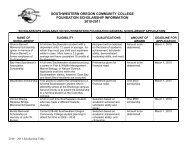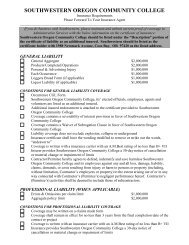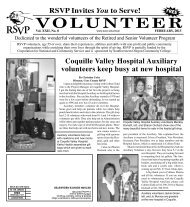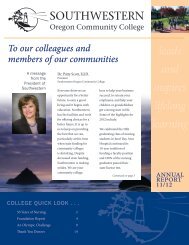Pronouns
Pronouns
Pronouns
Create successful ePaper yourself
Turn your PDF publications into a flip-book with our unique Google optimized e-Paper software.
1<br />
SOCC WRITING CENTER<br />
PRONOUNS<br />
<strong>Pronouns</strong> are words that take the place of nouns (words for persons,<br />
places, things, or ideas). In fact, the word pronoun means for a noun.<br />
<strong>Pronouns</strong> are short cuts that keep you from unnecessarily repeating<br />
words in writing. The rules for pronoun use are as follows:<br />
1. Reference rules<br />
A pronoun must refer clearly to the word it replaces. A sentence may<br />
be confusing and unclear if a pronoun appears to refer to more than<br />
one word, as in this sentence:<br />
An incorrect reference:<br />
I locked my suitcase in my car, and then it was stolen.<br />
What was stolen? It is unclear whether the suitcase<br />
or the car was stolen.<br />
A correct reference:<br />
I locked my suitcase in my car, and then my car was stolen.<br />
2. Agreement rules<br />
A. A pronoun must agree in number with the word or words it<br />
replaces. If the word a pronoun refers to is singular, the<br />
pronoun must be singular; if the word is plural, the pronoun<br />
must be plural. (Note that the word a pronoun refers to it<br />
known as the antecedent.)<br />
Lola agreed to lend me her Billie Holliday albums.<br />
The gravediggers sipped coffee during their break.<br />
In the first example, the pronoun her refers to the singular<br />
word Lola; in the second example, the pronoun their refers to<br />
the plural word gravediggers.<br />
B. The following words, known as indefinite pronouns, are<br />
always singular:<br />
one nobody nothing each
2<br />
anyone anybody anything either<br />
everyone everybody everything neither<br />
someone somebody something<br />
Note: Both always takes a plural verb.<br />
3. Point-of-View rule:<br />
<strong>Pronouns</strong> should not shift unnecessarily in point of view. When<br />
writing a paper, be consistent in your use of first-, second-, or<br />
third-person pronouns. The most common mistake people make is<br />
to let a you slip into their writing after they start with another<br />
pronoun.<br />
Type of Pronoun Singular Plural<br />
First-person pronouns I (my, mine, me) we (our, us)<br />
Second-person pronouns you (your) you (your)<br />
Third-person pronouns he (his, him) they (their, them)<br />
she (her)<br />
it (its)<br />
Note: Any person, place, or thing, as well as any indefinite pronoun<br />
like one, anyone, someone, and so on, is a third-person word.<br />
4. Subject and Object <strong>Pronouns</strong><br />
<strong>Pronouns</strong> change their form depending on the place they occupy in<br />
a sentence. Here is a list of subject and object pronouns.<br />
Subject <strong>Pronouns</strong><br />
I<br />
you<br />
he<br />
she<br />
it<br />
we<br />
they<br />
Object <strong>Pronouns</strong><br />
me<br />
you<br />
him<br />
her<br />
it<br />
us<br />
them<br />
A. Subject pronouns are subjects of verbs.<br />
Rule 1. Use a subject pronoun in a sentence with a<br />
compound (more than one subject).
3<br />
Incorrect<br />
Correct<br />
Dwayne and me went shopping.<br />
Dwayne and I went shopping.<br />
If you are not sure which pronoun to use, try each<br />
pronoun by itself in the sentence. The correct<br />
pronoun will be the one that sounds right. For<br />
example, “Me went shopping” does not sound right; “I<br />
went shopping” does.<br />
Rule 2. Use a subject pronoun after forms of the<br />
verb be.<br />
Forms of be include am, are, is, was, were,<br />
has been, have been, and others.<br />
For example,<br />
It was I who telephoned.<br />
It may be they at the door.<br />
It is she.<br />
The sentences above may sound strange to<br />
you, since this rule is seldom actually followed in<br />
conversation. When we speak with one another,<br />
forms such as “It was me,” “It may be them,” and<br />
“It is her” are widely accepted. In formal writing,<br />
however, the grammatically correct forms are still<br />
preferred. You can avoid having to use a subject<br />
pronoun after be simply by rewording the<br />
sentence. Here is how the preceding examples<br />
could be reworded:<br />
I was the one who telephoned.<br />
They may be at the door.<br />
She is here.<br />
Rule 3. Use subject pronouns after than or as when a<br />
verb is understood after the pronoun. For example,<br />
You read faster than I (read). (The verb “read”<br />
is understood after I.)<br />
Tom is as stubborn as I (am). (The verb “am”<br />
is understood after I.)
4<br />
We don’t go out as much as they (do). (The<br />
verb “do” is understood after they.)<br />
Notes:<br />
a. Avoid mistakes by mentally adding the “missing”<br />
verb at the end of the sentence.<br />
b. Use object pronouns after as or than when a verb is<br />
not understood after the pronoun.<br />
For example,<br />
The law applies to you as well as me.<br />
Our boss paid Monica more than me.<br />
5. Object <strong>Pronouns</strong><br />
Object pronouns (me, him, her, us, them) are the objects of verbs or<br />
prepositions. (Prepositions are connecting words like for, at, about,<br />
to, before, by, with, and of.)<br />
For example,<br />
6. Relative <strong>Pronouns</strong><br />
Nika chose me (Me is the object of the verb<br />
“chose.”)<br />
Don’t mention UFO’s to us. (Us is the object of the<br />
preposition “to.”)<br />
We met them at the park. (Them is the object of the<br />
verb “met.”)<br />
Relative pronouns do two things at once. First, they refer to<br />
someone or something already mentioned in the sentences.<br />
Second, they start a short word group that gives additional<br />
information about this someone or something. Here is a list of<br />
relative pronouns, followed by some example sentences:<br />
Relative <strong>Pronouns</strong><br />
who<br />
whose<br />
whom<br />
which<br />
that<br />
The only friend who really understands me is moving away.<br />
(Use who or whom, not that, for people.)<br />
Chocolate, which is my favorite food, upsets my stomach.<br />
I guessed at half the questions that were on the test.
5<br />
In the example sentences, who refers to “friend,” which refers to<br />
“chocolate,” and that refers to “questions.”<br />
In addition, each of these relative pronouns begins a group of<br />
words that describes the person or thing being referred to. For<br />
example, the words “which is my favorite food” give added<br />
information about chocolate.<br />
Point 1. Whose means belonging to whom. Be careful not to<br />
confuse whose and who’s, which means who is.<br />
Point 2. Who, whose, and whom all refer to people. Which<br />
refers to things. That refers to things or to a group of<br />
people (The board that).<br />
Point 3.<br />
Who, whose, whom, and which can also be used to<br />
ask questions. When they are used in this way, they<br />
are called interrogative pronouns.<br />
Note: In informal usage, who is generally used instead of whom as<br />
an interrogative pronoun. Informally, we can say or write,<br />
“Who are you rooting for in the game?” Or “Who did the<br />
instructor fail?” More formal usage would use whom. “Whom<br />
are you rooting for in the game?” and “Whom did the<br />
instructor fail?”<br />
Point 4. Who or whom are used differently. Who is a subject<br />
pronoun. Use who as the subject of a verb.<br />
Whom is an object pronoun. Use whom as the object<br />
of a verb or a preposition.<br />
7. Possessive <strong>Pronouns</strong><br />
Possessive pronouns show ownership or possession.<br />
Possessive <strong>Pronouns</strong><br />
my, mine<br />
your, yours<br />
his<br />
her, hers<br />
its<br />
our, yours<br />
your, yours<br />
their, theirs<br />
A possessive pronoun NEVER uses an apostrophe.
6<br />
8. Demonstrative <strong>Pronouns</strong><br />
Demonstrative pronouns point to or single out a person or thing.<br />
Demonstrative <strong>Pronouns</strong><br />
this<br />
that<br />
these<br />
those<br />
Generally speaking, this and these refer to things close at hand;<br />
that and those refer to things farther away.<br />
9.<br />
Reflexive <strong>Pronouns</strong><br />
Reflexive pronouns are pronouns that refer to the subject of a<br />
sentence.<br />
Reflexive Pronou ns<br />
myself herself ourselves<br />
yourself itself yourselves<br />
himself<br />
themselves<br />
Sometimes the reflexive pronoun is used for emphasis, for<br />
example,<br />
The president himself turns down the thermostat.<br />
Adapted<br />
from Langan, John. Sentence Skills, Form A. New York: McGraw-Hill, 2003.


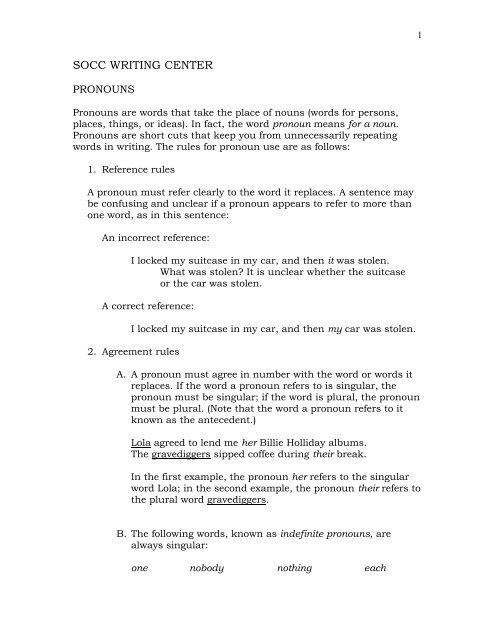
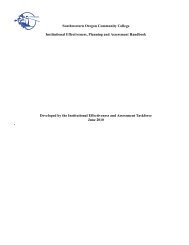

![SWOCC Viewbook [PDF] - Southwestern Oregon Community College](https://img.yumpu.com/26373688/1/190x245/swocc-viewbook-pdf-southwestern-oregon-community-college.jpg?quality=85)
